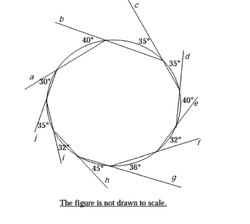A problem by Er Abhishek Gupta
Level
pending
 In the figure, a, b, c, d, e, f, g, h, i , and j are chords of the circle. Which two chords are parallel to each other?
In the figure, a, b, c, d, e, f, g, h, i , and j are chords of the circle. Which two chords are parallel to each other?
a and f
c and h
e and j
b and g
This section requires Javascript.
You are seeing this because something didn't load right. We suggest you, (a) try
refreshing the page, (b) enabling javascript if it is disabled on your browser and,
finally, (c)
loading the
non-javascript version of this page
. We're sorry about the hassle.
add up all the angles in between and if it gives 180, they're parallel, such is the case with E and J